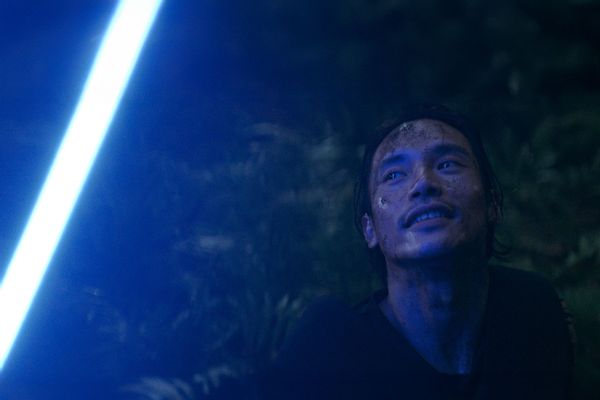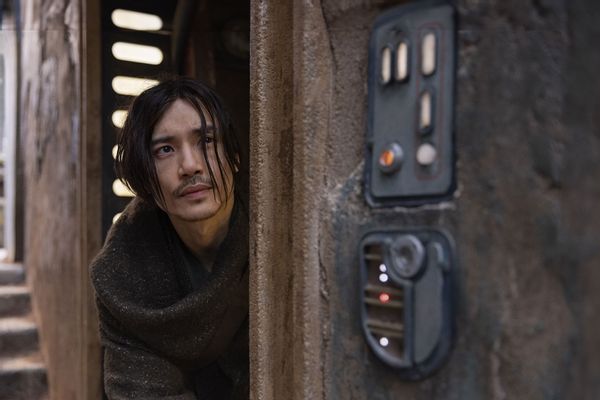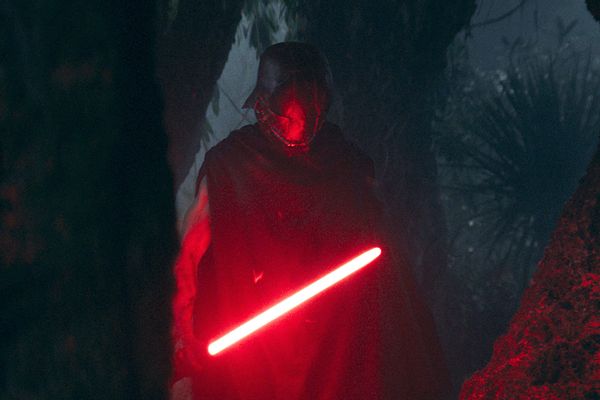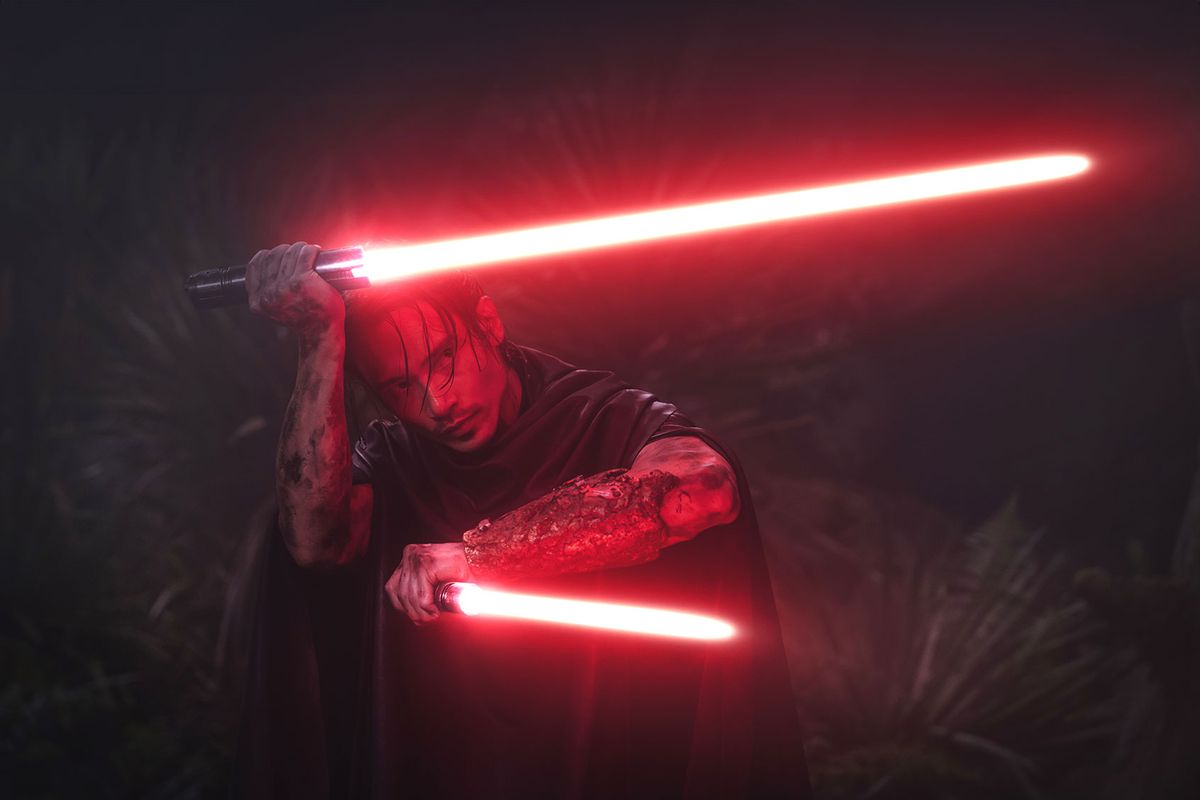The dark side of the Force has never been more violent or compelling than in Star Wars’ latest series “The Acolyte.”
In the June 25 episode "Night," it's revealed that goofy apothecary Qimir (Manny Jacinto) is in fact a Sith Lord master known as the Stranger, who's been secretly training assassin and acolyte Mae Aniseya (Amandla Stenberg) for several years. In a shocking sequence, Qimir brutally kills several Jedi, including stabbing one multiple times in the chest and snapping the neck of another. What’s been equally surprising are the reactions to Jacinto’s portrayal of the Stranger, or more specifically, how attractive his Sith master alter ego is.
“I now understand what the Kylo Ren girlies were on. This is my Kylo Ren. This is my Adam Driver,” tweeted X user emmailene_.
Similar reactions to the Stranger swept the internet, commenting not only on his looks, but also on his smirking, nonchalant response to murdering some of the main Jedi characters, intrigued and horrified in equal measure by how callous he is. People who hadn’t even been tuning into “The Acolyte” or weren’t fans of Star Wars suddenly expressed interest in the show after seeing gifs and fan edits of the big identity reveal, like this one.
The online response to Qimir’s true identity reveals a common tension coursing through the Star Wars franchise: is the story serving us dark side allure to entice us to tuning in, or perhaps to distract us – and the main characters – from the dangerous evil associated with the dark side?
Or are there more layers to the deliberate use of making the dark side characters physically attractive to tell a story from a different perspective?
Luke Skywalker (Mark Hamill) once chastised Rey (Daisy Ridley) for caving to the dark side for “a pair of pretty eyes” in a deleted scene from the film “The Last Jedi," after he walked in on her touching hands with Kylo Ren (Adam Driver) through the Force.
The dark side is very, very human, which makes it alluring. And the show knows it.
Indeed, the dark side of the Force can be very seductive. In “The Empire Strikes Back," Master Yoda tells Luke it can “dominate your destiny; consume you it will," referring to the central struggle of the Star Wars saga: the push and pull between the light side and dark, good and evil. These words can also accurately describe how more recent dark side villains, specifically the ones that arrived on our screens in the 21st century, are some of the series' most popular and lusted-after characters. We’re talking about Hayden Christensen’s Anakin Skywalker, Driver’s Kylo Ren, Asajj Ventress from “The Clone Wars,” Shin Hati from “Ashoka,” to name a few.
In the case of “The Acolyte,” the show is using the female gaze to tell the story from the female perspective, where women are depicted as subjects with agency and drive on the plot, versus the other way around. The female gaze also filters the story and the supporting characters through a lens contrary to the male gaze, which has traditionally objectified women on screen.
 Manny Jacinto as The Stranger in "Star Wars: The Acolyte" (Lucasfilm Ltd.)As Qimir fights off several Jedi, he’s ruthless and unafraid to fight dirty. In an extremely skilled move that dares to challenge the audience’s conceptions of what dark side Force users can do, he splits his red-bladed lightsaber into two separate sabers, using the shorter one to surprise attack his enemies. In another move, he short-circuits a Jedi’s lightsaber by headbutting them while wearing his helmet and uses the Force to move another one onto his lightsaber to kill them. There’s a raw aggression to Qimir’s the Stranger that feels less refined than what we’ve come to expect from the dark side. His confidence is borderline arrogant and his demeanor somewhat unnerving, evident when he casually drops back into his earlier disguised voice in a joking manner in the midst of a serious fight. The dark side is very, very human, which makes it alluring. And the show knows it.
Manny Jacinto as The Stranger in "Star Wars: The Acolyte" (Lucasfilm Ltd.)As Qimir fights off several Jedi, he’s ruthless and unafraid to fight dirty. In an extremely skilled move that dares to challenge the audience’s conceptions of what dark side Force users can do, he splits his red-bladed lightsaber into two separate sabers, using the shorter one to surprise attack his enemies. In another move, he short-circuits a Jedi’s lightsaber by headbutting them while wearing his helmet and uses the Force to move another one onto his lightsaber to kill them. There’s a raw aggression to Qimir’s the Stranger that feels less refined than what we’ve come to expect from the dark side. His confidence is borderline arrogant and his demeanor somewhat unnerving, evident when he casually drops back into his earlier disguised voice in a joking manner in the midst of a serious fight. The dark side is very, very human, which makes it alluring. And the show knows it.
We need your help to stay independent
While the episode “Night” was directed and written by men, the female gaze is nevertheless hard at work in this particular episode. It’s the primary reason why Qimir and unveiling his true identity have become such a big draw for the show, especially for female viewers, practically overnight. It’s not only that Jacinto is depicted in a physically attractive style, depicted with wet, messy hair and showcasing ripped bare arms, an image that feels catered to female viewers specifically. It’s the fact that Qimir is shown on screen from the perspectives of Mae and later, her twin sister Osha (also Stenberg) – and “The Acolyte” never strays from that.
The empathy of darkness
Applying the female gaze to the dark side of the Force takes anger, aggression and power – traits Yoda once called the “seductive” aspects of the dark side – and depicts them literally in the appearance of a villain who is not only frightening but also physically attractive and highly competent. From the female perspective, the temptation of the dark side can come in many forms.
At the end of the episode, after the surviving Jedi have escaped the battle, we see Qimir drape his cloak over an unconscious Osha in a display of tenderness at odds with his earlier acts of violence. This is an essential aspect of Qimir's appeal. Series creator Leslye Headland said that when she cast Jacinto, she commended his approach to the character because he did it “with the most amount of empathy.”
 Manny Jacinto as The Stranger in "Star Wars: The Acolyte" (Lucasfilm Ltd.)Yes, Qimir is terrifying, but there’s also a spark of humanity somewhere in the maelstrom of his violent nature and philosophy that makes him appealing. The dark side of the Force has always been characterized as a raw element of the galaxy that can’t exist without the light side and vice versa. Luke, Anakin, Rey and now Mae and Osha have all been tempted by the dark side and struggled to come to terms with the darkness inside themselves. In the cases of Rey, Mae and Osha in particular, the female gaze depicts their dark side villains with more complexity, one whose inner conflicts and mysteries they can’t help but find compelling.
Manny Jacinto as The Stranger in "Star Wars: The Acolyte" (Lucasfilm Ltd.)Yes, Qimir is terrifying, but there’s also a spark of humanity somewhere in the maelstrom of his violent nature and philosophy that makes him appealing. The dark side of the Force has always been characterized as a raw element of the galaxy that can’t exist without the light side and vice versa. Luke, Anakin, Rey and now Mae and Osha have all been tempted by the dark side and struggled to come to terms with the darkness inside themselves. In the cases of Rey, Mae and Osha in particular, the female gaze depicts their dark side villains with more complexity, one whose inner conflicts and mysteries they can’t help but find compelling.
It’s precisely because Qimir is frightening and dark that makes him appealing to women because it implies that he would accept their darkness as well. He’s violent, but he also doesn’t judge Mae when she wants to tap into her darker tendencies, which allows her to be a more well-rounded and relatable character. He later does the same for Osha who, disguised as Mae, can’t help but stare at Qimir with terrified interest when he questions her about killing a Jedi upon their first meeting.
I'm a loser, baby
The female gaze also favorably depicts the side of Qimir that goes against conventional attractiveness, a characteristic that can only be delicately defined as “loserism.”
Long before Qimir is revealed to be the Stranger on "The Acolyte," he presents himself as a simple apothecary who’s bumbling along in life and sells shady items for a living. His long side-swept bangs hairstyle is reminiscent of emo individuals in the early aughts of MySpace.com, which contrasts the straight-laced machismo of alpha men whose charm might see them mansplain and talk over women. He’s kind of pathetic-looking in the way quiet guys who sit at the back of the class wearing a hoodie over their heads are pathetic, yet at the same time all the more intriguing for his mystery.
And yet, he can sometimes be approachable. There’s a brief comedic scene when Qimir accidentally falls asleep while waiting for Mae and another moment with a humorous tone where he’s wearing goggles and lightheartedly waves at Osha. But this side of Qimir is still smart and listens to both women when they speak, which leads to Mae employing his help despite slightly distrusting him and Osha finding him scary but interesting.
 Manny Jacinto as Qimir in "Star Wars: The Acolyte" (Lucasfilm Ltd.)Loserism is attractive because these people have accepted their seemingly humble identities without seeking external validation, contrasting the typical male hero who might have underlying insecurities that they project onto others. What’s thrilling about Qimir is that it’s unexpected that a galaxy outcast could be so confident and self-assured about his darker and more socially unaccepted traits.
Manny Jacinto as Qimir in "Star Wars: The Acolyte" (Lucasfilm Ltd.)Loserism is attractive because these people have accepted their seemingly humble identities without seeking external validation, contrasting the typical male hero who might have underlying insecurities that they project onto others. What’s thrilling about Qimir is that it’s unexpected that a galaxy outcast could be so confident and self-assured about his darker and more socially unaccepted traits.
The same loserism can be said about Kylo Ren in the Star Wars sequel trilogy. And in fact, Headland draws a parallel between the two characters when she notes how Kylo Ren's theme plays over the aforementioned Qimir and Osha scene in "The Acolyte."
In "The Last Jedi," when Rey calls Kylo Ren a monster for killing Han Solo (Harrison Ford) in their second Force bonding scene, he responds, “I know,” implying he’s well-aware of his own shortcomings and perhaps guilt-ridden about his choices. When he offers to train Rey not once, but twice, he places himself at her mercy to accept or reject him, which the female gaze depicts as the culminating points of both installments of Rey’s story.
"I’ve accepted my darkness. What have you done with yours?"
While “The Last Jedi” was written and directed by a man, director Rian Johnson always kept the focus of the story on Rey and any scenes she had from her perspective. Kylo Ren not only represented the darker side of Rey’s emotions and temptations, but he also served as a companion who listened to her while she vented about her loneliness. In the hut scene when they touch hands, Kylo Ren is literally washed in soft, warm light as he assures Rey that she isn’t alone. And remember the infamous shirtless scene when Rey connects with Kylo Ren in another Force vision and he turns around in just his high-waisted pants, prompting an immense positive reaction from female fans?
That reaction prompted ire from the more conservative side of the fandom, known as The Fandom Menace. These are predominantly male fans of the franchise who don't care for the use of the female gaze that the franchise has undertaken led by Lucasfilm president Kathleen Kennedy but also despise the increased cast diversity, citing it as Disney’s “woke agenda.” Not much has changed since then with the predominantly queer actors of color in “The Acolyte” who also have received online backlash.
Other fans opposing this more female-friendly direction of the Star Wars universe cite the “woobification” of dark side villains like Kylo Ren, whom they claim is “problematic.” They also claim that his actions have been romanticized, which they say is an endorsement of the same behavior in real life, which frankly diminishes the intelligence of the series’ audience and their ability to discern the difference between reality and fiction.
Kylo Ren is one of the most popular characters from the sequel trilogy. In a stat following the release of “The Rise of Skywalker” in 2019, Kylo Ren was among the Top 10 most searched characters on Google that year, with more than 814,000 average monthly searches. Furthermore, the pairing between Rey and Kylo Ren, known as Reylo, launched an entire subset of modern romantic fiction inspired by them. These facts prove that the female gaze is one of the most marketable tools in the franchise’s arsenal.
Want a daily wrap-up of all the news and commentary Salon has to offer? Subscribe to our morning newsletter, Crash Course.
The evolution of the dark side's influence
If “The Acolyte” had been told from the male gaze, we’d likely get an in-depth backstory explanation for Qimir and how he came to be the Stranger following his reveal. But don’t expect that with Headland in control. The showrunner stated in an interview with “Entertainment Weekly" that “because it’s Osha’s story, you don’t know much about the Stranger’s background and you’re not really going to learn much about it. But there are a bunch of things in Episode 6 and Episode 8 that are really big clues as to why he is the way he is and why his philosophy is the way that it is.”
 Manny Jacinto as The Stranger in "Star Wars: The Acolyte" (Lucasfilm Ltd.)While Jacinto's appearance as the Stranger may be the main draw for some fans, it’s really the way his character is portrayed and how his story is told through the lens of the main female characters that has received the most attention.
Manny Jacinto as The Stranger in "Star Wars: The Acolyte" (Lucasfilm Ltd.)While Jacinto's appearance as the Stranger may be the main draw for some fans, it’s really the way his character is portrayed and how his story is told through the lens of the main female characters that has received the most attention.
https://x.com/Hissterically/status/1805968540651905359
The impact of the female gaze in “The Acolyte” and on the dark side characters in Star Wars prioritizes the female perspective in a universe dominated by male-centered stories and the embracing of more female fans into this galaxy far, far away, which has long been loudly saturated by male fans. In the original trilogy, Darth Vader is Luke’s villain filtered through the male gaze, representing the father figure that many young men want to please and are also frightened of. Making Rey the main character of the sequel trilogy ushered in a new era for the franchise, welcoming female fans more openly than ever before. Which is why her villain, Kylo Ren, as shown through the female gaze, is moreso her equal and counterpart in the dark side, than a father figure. In both trilogies, Luke and Rey must learn to accept the dark side, rather than push it away or be in fear of it. Similarly, Qimir reflects Mae’s and Osha’s darker thoughts and vengeful spirits, which Mae had given into, and Osha will likely get to experience a taste of it in the next episodes, as teased by being left alone with Qimir at the end of “Night.”
“I’ve accepted my darkness. What have you done with yours?” Qimir tells Sol during their climatic face-off. It’s a storytelling struggle as old as time. One thing remains true: Judging by the internet’s response, by making the ethos of the dark side as something tempting and also something one must accept to find balance, the female gaze propels “The Acolyte” and elevates the central thesis of the entire Star Wars series: how one must have a balance between the light and dark side of the Force, to its highest potential.
Read more
about this topic



Shares